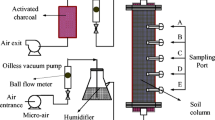Abstract
Soil vapor extraction (SVE) is an efficient, well-known and widely applied soil remediation technology. However, under certain conditions it cannot achieve the defined cleanup goals, requiring further treatment, for example, through bioremediation (BR). The sequential application of these technologies is presented as a valid option but is not yet entirely studied. This work presents the study of the remediation of ethylbenzene (EB)-contaminated soils, with different soil water and natural organic matter (NOMC) contents, using sequential SVE and BR. The obtained results allow the conclusion that: (1) SVE was sufficient to reach the cleanup goals in 63% of the experiments (all the soils with NOMC below 4%), (2) higher NOMCs led to longer SVE remediation times, (3) BR showed to be a possible and cost-effective option when EB concentrations were lower than 335 mg kg −1soil , and (4) concentrations of EB above 438 mg kg −1soil showed to be inhibitory for microbial activity.


Similar content being viewed by others
References
Albergaria, J. T., Delerue-Matos, C., & Alvim-Ferraz, M. C. M. (2006). Remediation efficiency of vapour extraction of sandy soils contaminated with cyclohexane: Influence of air flow rate and of water and natural organic matter contents. Environmental Pollution, 143(1), 146–152.
Alvim-Ferraz, M. C. M., Albergaria, J. T., & Delerue-Matos, C. (2006). Soil remediation time to achieve clean-up goals: II: Influence of natural organic matter and water contents. Chemosphere, 64, 817–825.
ATSDR, Agency for Toxic Substances and Disease Registry. (1999). Toxicological profile for ethylbenzene (update). Atlanta: Public Health Service, U.S. Department of Health and Human Services.
Corseuil, H. X., & Weber, W. J. (1994). Potential biomass limitations on rates of degradation of monoaromatic hydrocarbons by indigenous microbes in subsurface soils. Water Resources Research, 28, 1415–1423.
Fantroussi, S., & Agathos, S. N. (2005). Is bioaugmentation a feasible strategy for pollutant removal and site remediation? Current Opinion in Microbiology, 8(3), 268–275.
Grasso, D. (1993). Hazardous waste site remediation, source control. Connecticut: Lewis Publisher Inc.
Harper, B. M., Stiver, W. H., & Zytner, R. G. (1998). Influence of water content on SVE in a silt loam soil. Journal of Environmental Engineering and Science, 124, 1047–1053.
Jean, J. S., Lee, M. K., Wang, S. M., Chattopadhyay, P., & Maity, J. P. (2008). Effects of inorganic nutrient levels on the biodegradation of benzene, toluene, and xylene (BTX) by Pseudomonas spp. in a laboratory porous media sand aquifer model. Bioresource Technology, 99, 7807–7815.
Kelly, D. P., Baker, S. C., Trickett, J., Davey, M., & Murrell, J. C. (1994). Methanesulphonate utilization by a novel methylotrophic bacterium involves an unusual monooxygenase. 1Microbiology, 140, 1419–1426.
Lewis, D. L., Kollig, H. P., & Hodson, R. E. (1986). Nutrient limitation and adaptation of microbial populations to chemical transformations. Applied and Environmental Microbiology, 51, 598–603.
Poulsen, T. G., Moldrup, P., Yamaguchi, T., Schjonning, P., & Hansen, J. A. (1999). Predicting soil-water and soil-air transport properties and their effects on soil-vapor extraction efficiency. Ground Water Monitoring and Remediation, 19, 61–70.
Qin, C., Zhao, Y., Zheng, W., & Li, Y. (2010). Study on influencing factors on removal of chlorobenzene from unsaturated zone by soil vapor extraction. Journal of Hazardous Materials, 176(1–3), 294–299.
Romantshuck, M. (2000). Bioremediation of contaminated soil and groundwater. Environmental Pollution, 107, 179–185.
Sepehr, M., & Samani, Z. A. (1993). In situ soil remediation using vapor extraction wells, development and testing of a 3-dimensional finite-difference model. Ground Water, 31, 425–436.
Soares, A. A., Albergaria, J. T., Domingues, V. F., Alvim-Ferraz, M. C. M., & Delerue-Matos, C. (2010). Remediation of soils combining soil vapor extraction and bioremediation: Benzene. Chemosphere, 80, 823–828.
Sun, H., Tateda, M., Ike, M., et al. (2003). Short- and long-term sorption/desorption of polycyclic aromatic hydrocarbons onto artificial solids: Effects of particle and pore sizes and organic matters. Water Resources Research, 37, 2960–2968.
Suthersan, S. S. (1999). Soil vapour extraction. In Remediation engineering: Design concepts (pp. 27–88). Boca Raton: Lewis Publisher Inc.
Thomassin-Lacroix, E. J. M. (2000). Fate and effects of hydrocarbon-degrading bacterial used to inoculate soil for on-site bioremediation in the Arctic. M.S. Thesis, Royal Military College of Canada.
Tyagi, M., Fonseca, M. M. R., & Carvalho, C. C. C. R. (2011). Bioaugmentation and biostimulation strategies to improve the effectiveness of bioremediation processes. Biodegradation, 22, 231–241.
USEPA, United States Environmental Protection Agengy (2010). Superfund Remedy Report, 13th Ed.. Resource document. http://www.clu-in.org/asr/. Accessed 5 Mar 2010.
Yang, S. Z., Jin, H. J., Wei, Z., He, R. X., Ji, Y. J., Li, X. M., et al. (2009). Bioremediation of oil spills in cold environments: A review. Pedosphere, 19(3), 371–381.
Acknowledgments
The authors are grateful to the “Fundação para a Ciência e a Tecnologia (FCT)” for the financial support for this work (PTDC/ECM/68056/2006).
Author information
Authors and Affiliations
Corresponding author
Rights and permissions
About this article
Cite this article
Soares, A.A., Pinho, M.T., Albergaria, J.T. et al. Sequential Application of Soil Vapor Extraction and Bioremediation Processes for the Remediation of Ethylbenzene-Contaminated Soils. Water Air Soil Pollut 223, 2601–2609 (2012). https://doi.org/10.1007/s11270-011-1051-y
Received:
Accepted:
Published:
Issue Date:
DOI: https://doi.org/10.1007/s11270-011-1051-y




